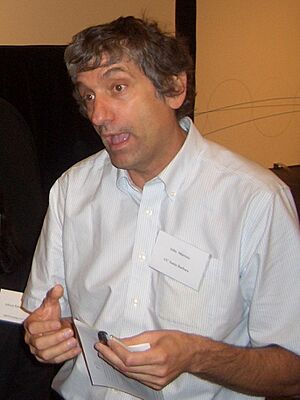John M. Martinis facts for kids
Quick facts for kids
John M. Martinis
|
|
|---|---|

Martinis in 2007
|
|
| Born |
John Matthew Martinis
1958 (age 66–67), U.S. |
| Education | University of California, Berkeley (BS, PhD) |
| Awards |
|
| Scientific career | |
| Thesis | Macroscopic quantum tunneling and energy-level quantization in the zero voltage state of the current-biased Josephson junction (1985) |
| Doctoral advisor | John Clarke |
John Matthew Martinis (born in 1958) is an American physicist. He is a Professor Emeritus of Physics at the University of California, Santa Barbara. He once led a special team at Google that worked on building super-fast quantum computers.
In 2019, his team used a special computer called the Sycamore processor. They announced that they had achieved something called quantum supremacy. This meant their quantum computer could solve a problem much faster than the best regular computers.
Martinis shared the 2025 Nobel Prize in Physics. He received this award with John Clarke and Michel Devoret. They were honored for their important work on how quantum rules can appear in larger, visible things, especially in materials called superconductors.
Contents
Meet John Martinis: A Quantum Pioneer
His Early Life and Learning Journey
John Matthew Martinis was born in 1958. He grew up in San Pedro, California. His father had moved to the United States from Yugoslavia to start a new life.
John went to the University of California, Berkeley. He earned his first degree in physics in 1980. Later, he completed his advanced degree, a Doctor of Philosophy in physics, in 1987.
During his studies, he explored how tiny quantum rules could affect larger electrical parts. He focused on a special electronic switch called a Josephson tunnel junction. His teacher, John Clarke, guided him. He also worked with Michel Devoret, another smart researcher.
In 1985, these three scientists showed how a Josephson junction behaved in a quantum way. This early work became a key idea for building quantum computers that use super-cold materials.
Building a Career in Quantum Science
After his studies, John Martinis worked in France at the Commissariat à l'Energie Atomique. He then joined the National Institute of Standards and Technology (NIST) in Boulder, USA. There, he worked on special devices called SQUIDs. These devices use superconductors to measure very tiny magnetic fields.
Google and the Quantum Leap
In 2014, the Google Quantum A.I. Lab announced exciting news. They hired John Martinis and his team. Their big goal was to build a quantum computer using special parts called superconducting qubits. Qubits are like the bits in regular computers, but they can do much more.
On October 23, 2019, Martinis and his team published a famous paper. It was titled "Quantum supremacy using a programmable superconducting processor." In this paper, they showed how their Sycamore processor achieved quantum supremacy. This processor had 53 qubits. It was a huge step forward in quantum computing.
In April 2020, Martinis left Google. He moved to an advisory role before leaving the company.
New Adventures in Quantum Computing
On September 29, 2020, it was announced that Martinis had moved to Australia. He joined a new company called Silicon Quantum Computing. This company was started by Professor Michelle Simmons. He continues his work on advanced quantum technologies there.
Awards and Recognitions
John Martinis has received several important awards for his scientific work.
In 2014, he shared the Fritz London Memorial Prize. He received it with Michel Devoret and Robert J. Schoelkopf. This prize recognizes achievements in low-temperature physics.
In 2021, he was awarded the John Stewart Bell Prize. This prize honors research into the basic ideas of quantum mechanics and how they can be used.
In 2025, he received the Nobel Prize in Physics. He shared this prestigious award with his former advisor John Clarke and Michel Devoret. They were recognized for discovering how quantum tunneling and energy levels work in electrical circuits. This showed how quantum mechanics can be seen in larger systems.
See also
 In Spanish: John Martinis para niños
In Spanish: John Martinis para niños

